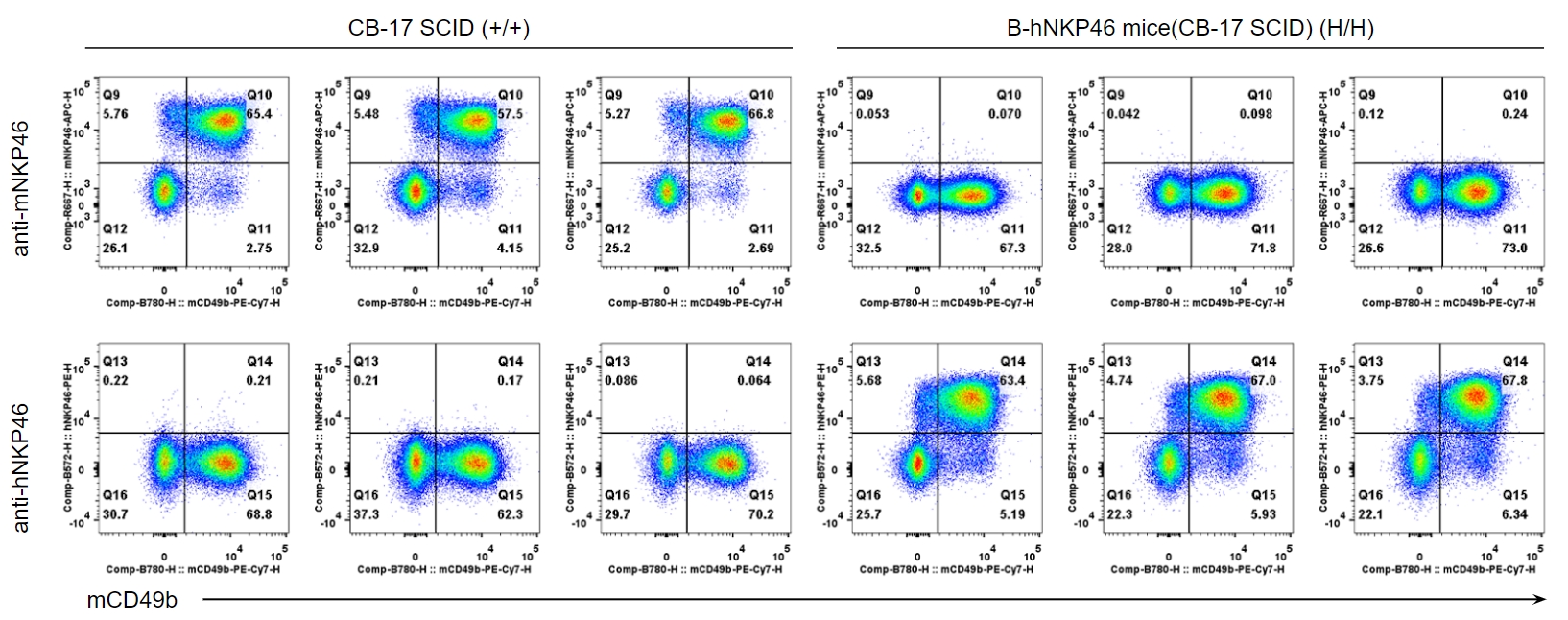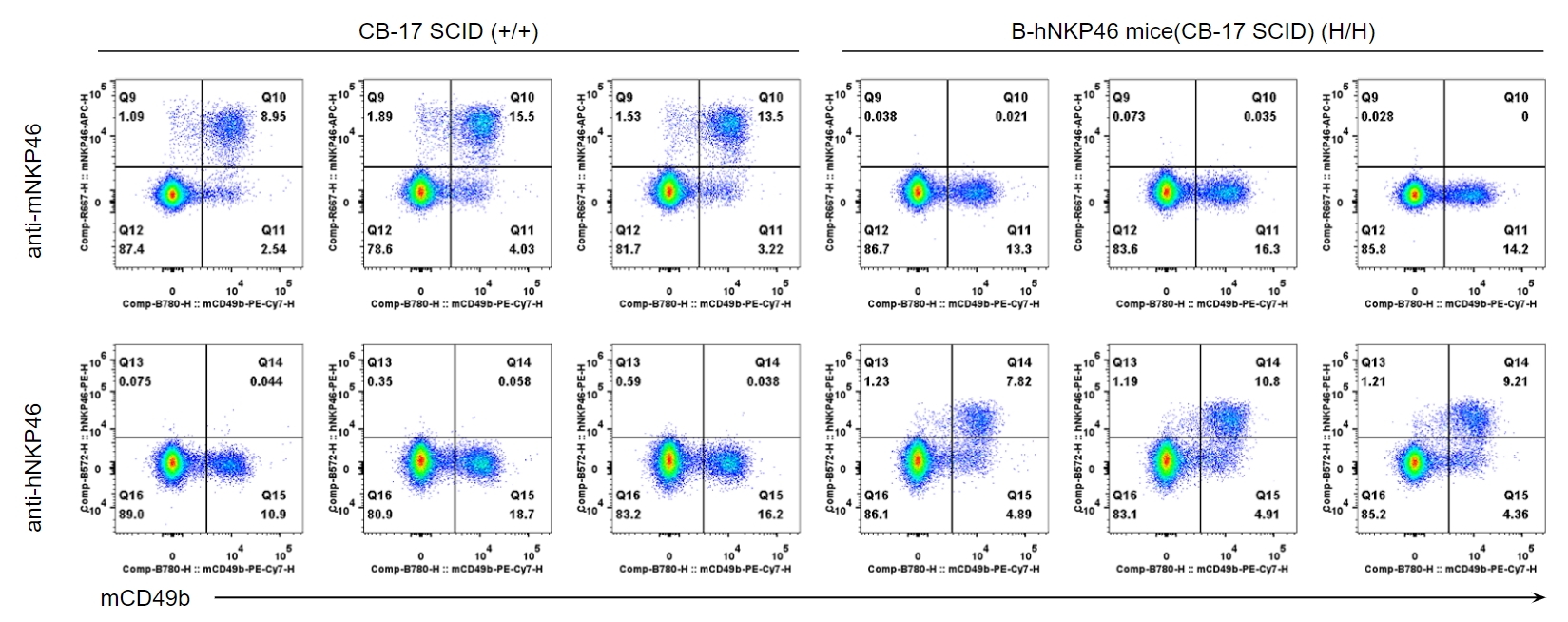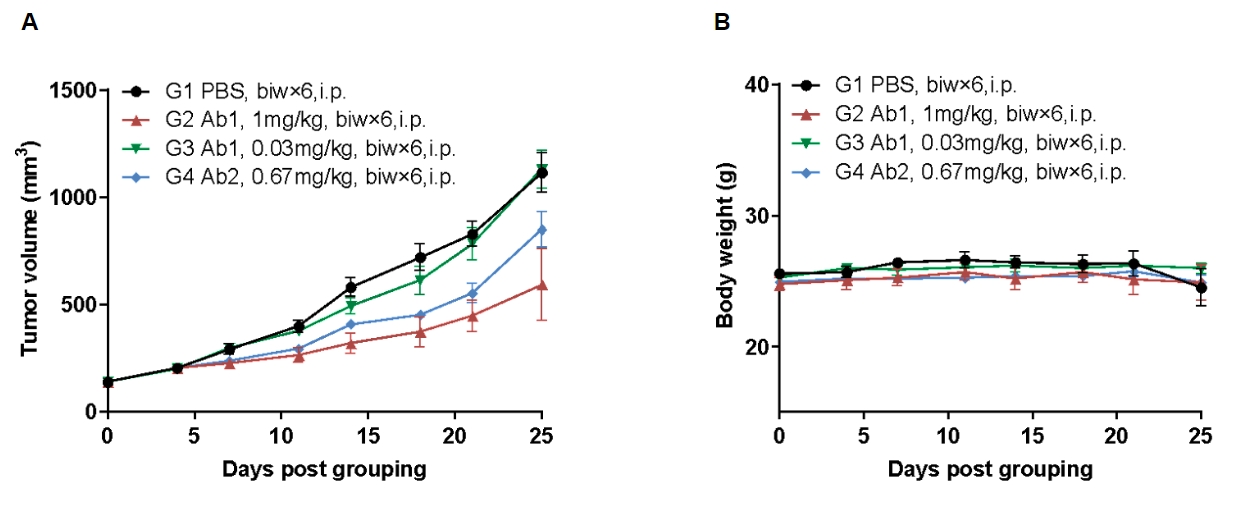Basic Information
-
Gene targeting strategy

-
Gene targeting strategy for B-hNKP46 mice(CB-17 SCID). The exons 1~7 of mouse NKp46 gene that encode the extracellular domain were replaced by human NKP46 exons 1~7 in B-hNKP46 mice(CB-17 SCID).
-
Protein expression analysis

-

Strain specific NKP46 expression analysis in wild-type and B-hNKP46 mice(CB-17 SCID) by flow cytometry. Splenocytes were collected from CB-17 SCID(+/+) and homozygous B-hNKP46 mice(CB-17 SCID)(H/H), and analyzed by flow cytometry with species-specific NKP46 antibody. Mouse NKP46 was detectable in wild-type mic. Human NKP46 was exclusively detectable in homozygous B-hNKP46 mice(CB-17 SCID).
-
Protein expression of NKP46 in spleen

-

Strain specific NKP46 expression analysis in wild-type and B-hNKP46 mice(CB-17 SCID) by flow cytometry. Splenocytes were collected from CB-17 SCID(+/+) and homozygous B-hNKP46 mice(CB-17 SCID)(H/H) (n=3, 6-week old), and analyzed by flow cytometry with species-specific NKP46 antibody. Mouse NKP46 was detectable in wild-type mic. Human NKP46 was exclusively detectable in homozygous B-hNKP46 mice(CB-17 SCID).
-
Protein expression of NKP46 in bone marrow

-

Strain specific NKP46 expression analysis in wild-type and B-hNKP46 mice(CB-17 SCID) by flow cytometry. Splenocytes were collected from CB-17 SCID(+/+) and homozygous B-hNKP46 mice(CB-17 SCID)(H/H) (n=3, 6-week old), and analyzed by flow cytometry with species-specific NKP46 antibody. Mouse NKP46 was detectable in wild-type mic. Human NKP46 was exclusively detectable in homozygous B-hNKP46 mice(CB-17 SCID).
-
Analysis of leukocytes cell subpopulation in spleen

-

Analysis of spleen leukocyte subpopulations by FACS. Splenocytes were isolated from female CB-17 SCID and B-hNKP46 mice(CB-17 SCID) (n=3, 6-week-old). Flow cytometry analysis of the splenocytes was performed to assess leukocyte subpopulations. A. Representative FACS plots. Single live cells were gated for the CD45+ population and used for further analysis as indicated here. B. Results of FACS analysis. Percent of T cells, B cells, NK cells, dendritic cells, granulocytes, monocytes and macrophages in homozygous B-hNKP46 mice(CB-17 SCID) were similar to those in the CB-17 SCID mice, demonstrating that NKP46 humanized does not change the overall development, differentiation or distribution of these cell types in spleen. Values are expressed as mean ± SD.
-
Analysis of leukocytes cell subpopulation in bone marrow

-

Analysis of spleen leukocyte subpopulations by FACS. Bone marrow cells were isolated from female CB-17 SCID and B-hNKP46 mice(CB-17 SCID) (n=3, 6-week-old). Flow cytometry analysis of the splenocytes was performed to assess leukocyte subpopulations. A. Representative FACS plots. Single live cells were gated for the CD45+ population and used for further analysis as indicated here. B. Results of FACS analysis. Percent of T cells, B cells, NK cells, dendritic cells, granulocytes, monocytes and macrophages in homozygous B-hNKP46 mice(CB-17 SCID) were similar to those in the CB-17 SCID mice, demonstrating that NKP46 humanized does not change the overall development, differentiation or distribution of these cell types in spleen. Values are expressed as mean ± SD.
-
Analysis of leukocytes cell subpopulation in blood

-

Analysis of spleen leukocyte subpopulations by FACS. Blood cells were isolated from female CB-17 SCID and B-hNKP46 mice(CB-17 SCID) (n=3, 6-week-old). Flow cytometry analysis of the splenocytes was performed to assess leukocyte subpopulations. A. Representative FACS plots. Single live cells were gated for the CD45+ population and used for further analysis as indicated here. B. Results of FACS analysis. Percent of T cells, B cells, NK cells, dendritic cells, granulocytes, monocytes and macrophages in homozygous B-hNKP46 mice(CB-17 SCID) were similar to those in the CB-17 SCID mice, demonstrating that NKP46 humanized does not change the overall development, differentiation or distribution of these cell types in spleen. Values are expressed as mean ± SD.
-
In vivo efficacy of anti-human NKP46-based Ab in B-hNKP46 mice(CB-17 SCID)

-

Antitumor activity of anti-human NKP46-based Ab in B-hNKP46 mice(CB-17 SCID). (A) Anti-human NKP46-based Ab inhibited BxPC-3 tumor growth in B-hNKP46 mice(CB-17 SCID). BxPC-3 cells (5E6) were subcutaneously implanted into B-hNKP46 mice(CB-17 SCID) (male, 7-8 week-old, n=4). Mice were grouped when tumor volume reached approximately 150-200 mm3, at which time they were treated with anti-human NKP46-based Ab with doses and schedules indicated in panel A. (B) Body weight changes during treatment. As shown in panel A, anti-human NKP46-based Ab was efficacious in controlling tumor growth in B-hNKP46 mice(CB-17 SCID). Values are expressed as mean ± SEM. (All antibodies were provided by the clients)

Antitumor activity of anti-human NKP46-based Ab in B-hNKP46 mice(CB-17 SCID). (A) Anti-human NKP46-based Ab inhibited BxPC-3 tumor growth in B-hNKP46 mice(CB-17 SCID). BxPC-3 cells (5E6) were subcutaneously implanted into B-hNKP46 mice(CB-17 SCID) (male, 7-8 week-old, n=6). Mice were grouped when tumor volume reached approximately 100-150 mm3, at which time they were treated with anti-human NKP46-based Ab with doses and schedules indicated in panel A. (B) Body weight changes during treatment. As shown in panel A, anti-human NKP46-based Ab was efficacious in controlling tumor growth in B-hNKP46 mice(CB-17 SCID). Values are expressed as mean ± SEM. (All antibodies were provided by the clients)
-
Posters

-
Humanized NKP46 mouse models for testing novel NK cell-based immunotherapies
-
Summary

-
- Protein expression analysis:
Human NKP46 was exclusively detectable in homozygous B-hNKP46 mice(CB-17 SCID), and mouse NKP46 was detectable in wild-type mice.
- Leukocytes profile:
Percentages of T, B, NK cells, monocyte/macrophages, and DC were similar in homozygous B-hNKP46 mice(CB-17 SCID) and wild-type mice, demonstrating that introduction of hNKP46 in place of its mouse counterpart does not change the overall development, differentiation, or distribution of these cell types in spleen, bone marrow and blood.


